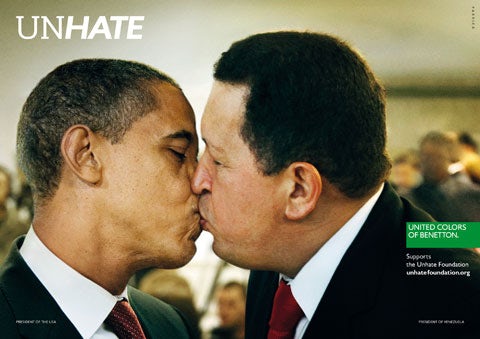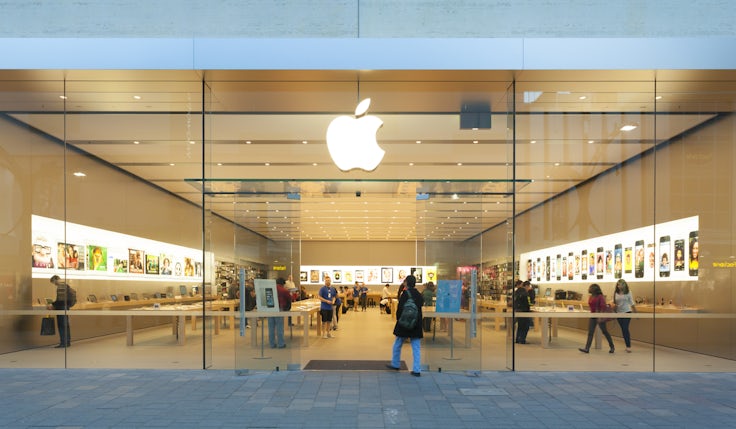United ideas of creative minds
Rather than push products at people using advertising, brands including Red Bull and Benetton are using a strategy of creating interesting content to attract attention or sponsoring causes that capture their essence.

“Fabrica’s specialism isn’t selling products, it’s communicating social ideas,” Gianluca Pastore, director of communications at Benetton, tells Marketing Week during a tour of the luxurious villa complex near Venice that houses the brand’s in-house creative agency.
Fabrica, which grants annual scholarships to young artists and designers, is a constant source of creativity for Benetton, providing it with the concepts and imagery behind many of the brand’s marketing campaigns.
Yet throughout the various studios of Fabrica, ranging from sculpture to video production, there is little sign of work related to Benetton’s fashion products. Instead, the creative work for Benetton is a stark mix of highly politicised and often controversial ideas: a Photoshopped image of Barack Obama kissing Venezuelan president Hugo Chavez, for example, or a statue of a peace dove made from bullets collected in Libya. It could be called anti-product marketing – indeed, Pastore describes it as ‘visual communications’ rather than advertising.
The work forms part of ‘Unhate’- a foundation established by company chairman Alessandro Benetton in November 2011. Benetton describes Unhate as a core part of its new corporate social responsibility policy and a means of “fighting the culture of hatred in line with Benetton Group’s deep-rooted values”. But Unhate is also central to the brand’s advertising strategy and its other external brand communications.
For example, Benetton recently launched its ‘Unemployee of the Year’ campaign. Run through the Unhate foundation, unemployed people aged 18 to 30 participated in an online competition by submitting ideas on ways to make the world a better place. The online community voted on the best 100 entries, with each winner receiving financial support from the foundation.
This is a major marketing spend by Benetton and supported by outdoor and online advertising, but nowhere in the campaign does the brand feature its products. Such an approach seems perplexing at a time when Benetton sales are struggling; before it delisted from the Milan Stock Exchange in May, it reported a 5.5 per cent fall in revenue in the first quarter as a result of weak demand in key European markets.
The brand has sought to rise above the energy drinks market and be known as an exciting brand across its core content verticals of sport, culture and lifestyle
Benetton’s response, though, has been to stick with a marketing approach that sidesteps products in favour of social ideas that define the brand as tolerant, multicultural and peace-promoting. The aim is to connect Benetton with its target market of socially aware young people and maintain its reputation as a controversial, edgy brand. This began in the 1980s, when Benetton started depicting topics like Aids and war in the Middle East through searing imagery produced by photographer Oliviero Toscani.
“It’s no secret that in today’s world the market is very tough for Benetton,” says Alessandro, who took over from his father and company founder Luciano Benetton in April. “It’s normal that this happens to companies with a long and successful history. But at the same time, whenever I go around the world, I always find that there is still a strong appreciation for what the Benetton brand stands for. The excitement and level of interest it still provokes is amazing.”
The company believes that in order to ride out its troubles and confirm its distinctive market positioning, it must consolidate this identity. Its decision to announce a new management structure at Fabrica last month is intended to help drive that strategy (see case study, below).
There are parallels between Benetton and Red Bull, the Austrian energy drinks maker whose brand image also exceeds its main product offering. Using the drink’s adrenaline-giving properties as a starting point, and the slogan ‘Red Bull gives you wings’, the brand has become synonymous with high-octane activities such as cliff diving and microlight aircraft races. Like Benetton, which had a championship winning Formula 1 team in the 1990s, Red Bull is now the dominant force in the sport.
And similar to the Italian fashion house, Red Bull has also crafted its image with the aid of an internal creative agency. The Red Bull Media House, near Salzburg, incorporates multimedia capabilities including telecom company Red Bull Mobile, Red Bull TV and a publishing department that produces the consumer-facing magazine, The Red Bulletin.
But for all its content and global presence at sporting events, Red Bull is conscious not to push its energy drinks too much. (Rather it finds that licensing the content it creates is a lucrative part of the business.) The brand has sought to rise above the energy drinks market and be known as an exciting brand across its core content verticals of sport, culture and lifestyle.
Christian Graf-Simpson, producer at The Red Bulletin, says: “The whole strategy at Red Bull has been to avoid having too many logos and the Red Bull name everywhere. With something like The Red Bulletin the name should appear somewhere on Red Bull-related content but it’s also the case that other TV stations or publishers should be able to use the content.”
Red Bull and content

Central to Red Bull’s business model is content licensing, whereby the company uses platforms like Red Bull TV to distribute content to other media outlets. For example, after the Red Bull Stratos event in October, in which skydiver Felix Baumgartner became the first person to break the sound barrier in freefall during a ‘space jump’, the brand licensed its content to the BBC for a documentary on the project.
Events like Stratos are of course big PR exercises for Red Bull that help to confirm its reputation as an exciting, adrenaline-fuelled brand rather than simply a drinks manufacturer. In the run-up to Stratos, The Red Bulletin featured monthly updates and videos on the progress of the project, while the magazine’s app streamed live footage of the jump.
“There are so many ways that Red Bull engages and fascinates people and a really good platform for that is the iPad,” says Graf-Simpson. “It’s made for Red Bull content.”
Red Bull’s content pool and licensing deals show that branching out from a brand’s immediate product can be a huge revenue generator. For example BabyCentre, which offers online information to expectant parents, has developed an additional business arm through which it provides in-depth research services to brands aimed at mothers.
By harnessing information from its community of more than 30 million mothers around the world, BabyCentre has established itself as an authority on parental behaviours and attitudes rather than just an online forum that offers advice to new mothers. This has allowed it to produce detailed reports on topics like shopping habits and mobile usage among parents, which are then sold as market insight to brands like Procter & Gamble and Nestlé.
Mike Fogarty, senior vice-president and global publisher at BabyCentre, explains: “Increasingly we’re seeing opportunities to reach marketers. There are big global portals like AOL and Yahoo! that have parenting solutions but they’re mostly for entertainment or the content is lifestyle-focused, so they’re just scratching the surface of the opportunity.
“We have made a disproportionate investment relative to other companies that has allowed us to go deep in terms of understanding this market segment. We focus on making sure we have a great consumer experience first of all and then the other side of our business is connecting marketers with that audience.”
Not all businesses have such an integrated approach to their content strategies, of course. Specialist business insurer Hiscox, for example, recently launched its ‘Informed’ app as a means of engaging with its target audience of small and medium-sized enterprises on a more regular basis. The free app, developed in partnership with media agency Vizeum, channels content from news websites that Hiscox has deemed relevant for its market, allowing users to stay updated on business topics.
While the app is not a major piece of content creation by Hiscox, serving more as an aggregator of existing news on the web, it allows the brand to reposition itself as a first port of call for SMEs in their marketplace.
“Insurance is usually a once-a-year purchase, so having the app means we can maintain contact with our customers and share expertise with them,” says Sarah Faulkner, broker marketing manager. “We’re not selling insurance or selling products through the app: it’s a way for us to develop our reputation as a thought leader and a trusted business partner with SMEs.”
Case study: Fabrica and Benetton

Fabrica is described as the “communication research centre” of Benetton. It was established by the Italian fashion house in 1994 as a means of combining cultural and artistic disciplines with more commercial marketing practices. Based in a restored villa complex near Venice, the centre also offers annual scholarships to around 40 young artists and designers.
Fabrica is considered central to Benetton’s long-standing brand strategy of presenting controversial views on challenging global issues, usually with no reference to its own products. For example, it played a key role in developing the ‘Unhate’ foundation, which Benetton launched late last year.
This campaign, which featured forged images of world leaders kissing, received a mixed response: it won the Press Grand Prix at the Cannes Festival of Creativity earlier this year, but it also landed Benetton in trouble with the Catholic Church over an image of the Pope kissing a Muslim cleric.
Although Benetton dropped the ad following a legal challenge by the Vatican, the episode has not discouraged the brand from pursuing its politically charged and confrontational marketing style. Last month it announced a new management structure at Fabrica in order to reaffirm its “vocation as a leader in social communications”.
Dan Hill, a former BBC executive, was appointed managing director of Fabrica and Paul Thompson, rector of the Royal College of Art, is to preside over a new advisory board for the centre: moves that Benetton believes will give the agency a more international and academic perspective.
In addition to its campaigns for Benetton, Fabrica produces a range of creative work for different media clients including music videos, documentaries and art gallery installations. The centre also produces campaign work for charities and non-governmental organisations like Unicef.
Despite speculation that under Fabrica’s new management structure the centre will operate more like a traditional advertising agency, developing product-centric campaigns for any brand that wants the service, Benetton insists the centre will remain true to its social conscience.
“Fabrica is not becoming an advertising agency; it will remain a visual communications centre,” says Gianluca Pastore, director of communications at Benetton. “[Fabrica] is open to any brand that wants to make use of the creative skills here but they must have a social purpose in what they want to do. Our specialism is not selling products, it’s communicating social ideas.”






